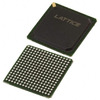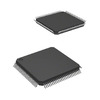Manufacturer Part Number
LC4256V-5FTN256AC
Manufacturer
Lattice Semiconductor
Introduction
The LC4256V-5FTN256AC is a part of Lattice Semiconductor's ispMACH® 4000V series, designed for high-performance, low-power complex programmable logic applications.
Product Features and Performance
In System Programmable
Complex Programmable Logic Device (CPLD)
Maximum propagation delay time of 5 ns
Equipped with 256 macrocells and 16 logic blocks
Supports 128 input/output ports
Operates within a voltage range of 3V to 3.6V
Functional at temperatures ranging from 0°C to 90°C
Product Advantages
High integration facilitating smaller board space and lower power consumption
Fast propagation delay enhances overall device performance
Ample I/O and macrocell count cater to complex designs
Key Technical Parameters
Delay Time tpd(1) Max: 5 ns
Voltage Supply Internal: 3V ~ 3.6V
Number of Logic Elements/Blocks: 16
Number of Macrocells: 256
Number of I/O: 128
Operating Temperature: 0°C ~ 90°C
Quality and Safety Features
Robust surface mount LBGA packaging ensures reliable soldering and mounting integrity
Operates reliably within a broad temperature range ensuring stability in variable environments
Compatibility
Compatible with 256-FTBGA (17x17) device packages
BGA package enables efficient heat dissipation and reduced cross-talk
Application Areas
Suitable for various high-performance logic applications including automotive, communication infrastructure, data center technology, and industrial automation
Product Lifecycle
Product status is active
Not reported as nearing discontinuation
Potential availability of future replacements or upgrades
Several Key Reasons to Choose This Product
High-speed performance with maximum propagation delay as low as 5 ns
Extensive configuration possibilities with 256 macrocells and 16 logic blocks
Broad operating temperature range making it suitable for a variety of industrial applications
Efficient power management sustaining operations at minimal voltage supplies
Robust packaging enhances the longevity and reliability of the device in complex environments



 LC4256V-5F256BCLattice Semiconductor CorporationIC CPLD 256MC 5NS 256FPBGA
LC4256V-5F256BCLattice Semiconductor CorporationIC CPLD 256MC 5NS 256FPBGA LC4256V-5T176CLattice Semiconductor CorporationIC CPLD 256MC 5NS 176TQFP
LC4256V-5T176CLattice Semiconductor CorporationIC CPLD 256MC 5NS 176TQFP LC4256V-5T100CLattice Semiconductor CorporationIC CPLD 256MC 5NS 100TQFP
LC4256V-5T100CLattice Semiconductor CorporationIC CPLD 256MC 5NS 100TQFP